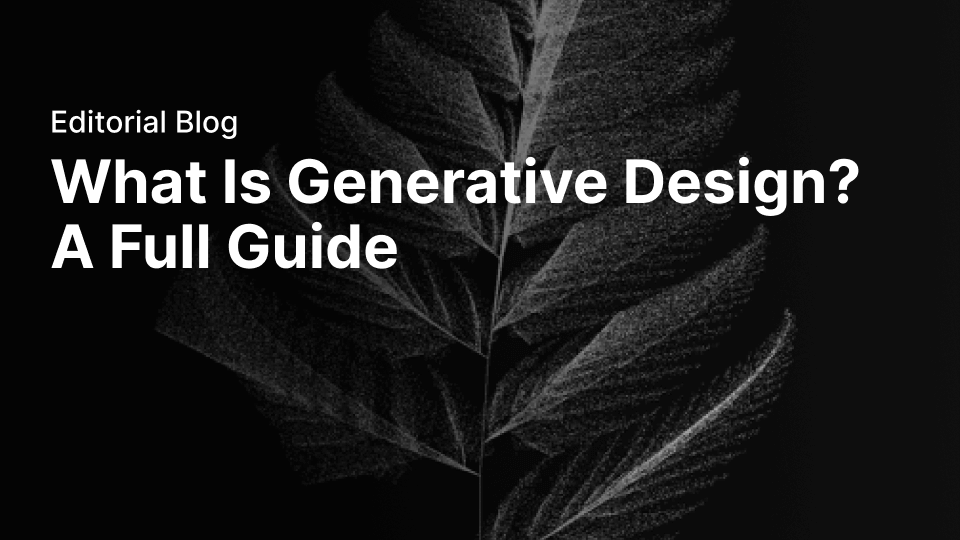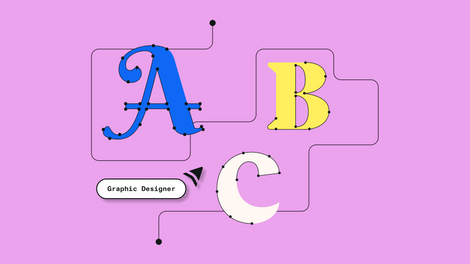Generative design is a design exploration process that uses AI to create a wide range of solutions and ideas for complex problems. But does this technology mean people are no longer needed to design? Will AI take over the design world as we know it? Let's find out.
It harnesses the power of AI to develop high-performance and highly sophisticated design iterations that help solve complex challenges, like reducing component weight, or optimizing performance, and making designs simpler.
Jumpstart your ideas with Linearity Curve
Take your designs to the next level.
At first glance, it might seem like generative design is only used by engineers. It isn't. Artificial intelligence in design is a force that has taken many creative industries by storm.
But don't worry, no need to get Matrix PTSD, and no need to feel like machine learning is taking over our hard-earned jobs as designers. We'll explain to you what generative design is, where it can be applied, and (*sigh of relief*) what its constraints are.

Where is generative design applied?
To help you better understand why, think of this. Let's say you want to design a stadium. But you have two fighting principles: You want to get lots of people into your stadium, but you also want all of them to have a good view of the game.
To help you better understand why, think of this. Let's say you want to design a stadium. But you have two fighting principles: You want to get lots of people into your stadium, but you also want all of them to have a good view of the game.
Instead of reinventing The Colosseum and wracking your brain trying to design something that fits, there is a very straightforward mathematical formula you can use to quantify the quality of the view, which can then be put in relation or opposition to the size of the stadium.
So, with a generative system in place, you can put those two principles at work to find a solution in such a way that people may have not seen or thought of before.
If you're asking yourself ‘when will I ever design a stadium?' let's look at a more practical example. Say you want to tile a countertop that has an irregular shape, and you want to figure out the optimal design and shape of your tiles, to minimize the amount of waste. That's where generative design can help.
Generative design has almost infinite applications, especially in industrial contexts, like the manufacturing industry. Airbus, the famous airplane manufacturer, used generative design to reimagine an interior partition of its A320 aircraft.
.png)
By harnessing the power of generative design software, they came up with a solution that ultimately saved 45% of the part's weight, equal to 30 kilograms.
This weight reduction means the aircraft uses less fuel, which in turn will reduce the carbon footprint of the air transport industry at large. Shaving off 30 kilograms per aircraft across their entire fleet is equivalent to removing the emissions of 96,000 passenger cars every year.
To complete its mission, the lander needs to operate in temperatures far below zero and withstand radiation levels thousands of times greater than those we experience on Earth.
With the help of generative design technology, Nasa alongside Autodesk came up with a design solution that performs well under all these demanding project parameters; a solution that a human engineer might not have been able to envision, at least not in the same time frame.
Autodesk is one of the leading generative software companies in the world, and they are not just spearheading the use of generative design in space. Take automotive for example.
Unleash Your Creative Potential in Design
Discover the endless possibilities of illustration in design. Learn how our tools can help you create stunning, unique designs effortlessly.
At last year's Autodesk University event, the Design & Manufacturing Keynote centered on "Elevate". A concept from Hyundai which is employing generative design technology to develop a new vehicle that has the ability to "walk". You read that right. A vehicle that can alternate between driving and "walking" functions to reach terrains that were never thought possible before.
While a generative design application can help to conceptualize complex design solutions, 3D printing is the ideal technology to bring these intricate shapes to life.

Everything is better in 3D
Paradoxically, generative design algorithms often create highly organic shapes that are essential for particular types of performance-sensitive applications.
These models are oftentimes impossible to fabricate with conventional manufacturing technologies such as injection molding. But 3D printing and additive manufacturing have kicked the door wide open.
If you think about it, generative design and 3D modeling are a match made in heaven. The PB&J of engineering. Generative design provides the 3D industry with fast and flexible means of producing three-dimensional, high-resolution models of multiple design iterations for a cost-effective final product.
Through additive processes which allow the deposition of thin layers of materials over and over, manufacturers can create parts with any type of solid material from plastic, to resin (SLA), and even metal.
This internal lattice of an outsole designed by New Balance is a perfect example of how organic generative designs can look:

3D printing and additive manufacturing played a major role in the growth of generative manufacturing solutions across industries.
However, it would be misleading to state that generative design is limited to only 3D printing. Additive technology is most of the time the most optimal production method. But in some cases, you can make use of more traditional manufacturing methods like CNC machining, casting, or injection molding, in addition to additive manufacturing.
So what are the benefits, again?
For one, we have simultaneous exploration.
The way that generative design works is that the designer specifies and inputs all criteria for the part design, based on parameters such as weight, material, size, cost, strength, and manufacturing methods.
The generative design software uses algorithms to explore the possibilities of these parameters, to generate thousands of design options. Then, the AI-powered software will analyze each design and determine the most efficient ones.
Then, of course, we have the accelerated design timeline. Sometimes traditional design can be like a game of battleship. You might try H3, and you might get a hit or a miss. And then you try again. With generative design, you can evaluate all the choices at once.
Companies can use generative design to gain a competitive advantage in accelerating products to market.
To determine the geometry of the design so quickly, generative design algorithms make use of different approaches, such as:
- Biomimicry: a practice that mimics nature to solve human design challenges
- Morphogenesis: the process by which an organism, tissue, or organ develops its shape
- Typology optimization: often confused with generative design, however, they are not the same.
Topology optimization vs generative design
We also have sizing optimization in that sense, which deals with finding the shape which is optimal and minimizes costs while satisfying a given set of rules.
So once the shape is predetermined, topology optimization is then concerned with the number of connected components that belong to or can fit within this shape.
Even after defining it, topology optimization and generative design might still sound similar. Yet the difference lies in the overall process.
Topology optimization begins with one complete human-designed model, created according to the predetermined loads and constraints. And it renders just one optimized concept for evaluation, based on the human-designed concept. There is no automated ideation.
This is where it differs from generative design, which begins by inputting the constraints, which are then analyzed by an AI, to determine hundreds or thousands of topological concepts.
But the numbers are not the only thing differentiating these two processes. What topology optimization doesn’t account for is that any design developed through traditional means is essentially biased.
In generative design, the AI will not be affected by biases (at least not as directly) and can explore beyond what we can imagine. We just need to make sure that our pre-existing shortcuts, preconceptions, and biases are not hard coded into artificial intelligent technology.
Will AI replace me as a designer?
First, you need to understand that generative design is not a brand-new phenomenon. People have been using generative design as far back as the nineties. But it never had the level of use and application across so many different industries that it has today.
So, the simple answer to the question is 'no.'
Without a doubt, generative design seems like an enticing option. Rather than having a designer laboriously create a handful of concepts, you can use an algorithm to quickly generate thousands of options and ask the designer to pick the best.
The designer shifts from being the creator to becoming the editor. What's not to like? Well, there are a few problems, actually.
When using generative design, there is no pre-built algorithm for generating all the design options. The designers will have to create their own system from scratch, which is not a small feat.
For this reason, many generative design tools are restricted to a limited number of design issues, or only a portion of the design process. Thus, making this stage of the design expensive, disjointed, and tedious.
Also, quantity does not mean quality. Generative designs generate thousands of different options. While this is celebrated like it's a virtue, there is a downfall: the algorithms can't really tell good ideas from bad unless you tell them what is good or bad. This is again where our biases sneak in.
Comparing the many, many options the system renders is yet another challenge. It takes a very skilled person to do so; and to further complicate things, humans hate having too many choices. We are facing the "paradox of choice" here. More choices give us more opportunities to make the wrong decision, which is something we fear.
And let's face it—designers (and people in general) don't work like this.
Designers do not follow a linear process, and design is actually pretty messy. Don't we know it.

The generative design process in itself requires a designer to not only understand and determine the parameters, but also analyze the best solutions in the end. An AI simply does not have the capability to understand the problem in itself. It executes based on the input design goal.
While your mind might go crazy picturing what an AI is actually capable of, in generative design, there is a focus on a slightly different form of artificial intelligence: a class referred to as “search algorithms.” Which is not exactly a neural network that is capable of learning and adapting by itself.
The advantage of the search algorithm is that it does not need to know anything about the internal workings of the part that is being designed. It will design a chair, without fundamentally knowing what a chair is.
These algorithms actually rely on repetitive testing rather than direct solving. So generative design does not solve your issue, but it explores the problem outside the box, so to say. It’s the designers and engineers who have to figure it out.
Can generative design get creative?
Now that we've understood there is nothing to fear, let's have a look at some unexpected examples of generative design that will make you fall in love with it. Or at least like it as a friend.
Here is an example of a digital painting created by the Paris-based collective, Obvious, with the help of artificial intelligence. Can you guess how much it sold for?

It auctioned for a whopping $432,000 at Christie's—the first auction house to put an artwork generated by an algorithm under the hammer. The same auction house that sold Beeple's $6.8 million NFT.
Obvious created the work using generative design and input information from 15,000 portraits. You can literally see the design process of the AI. The portrait depicts a man dressed in a dark frock coat with a plain white collar showing through.
Ready to create brand assets that pack a punch?
Visit our Academy for free design courses.
Arguably the most interesting part of the artwork is the fact that it is signed with the mathematical formula of the algorithms used to create it.
Another example is a set of marble vases and tables created by Iraqi-born designer Layth Mahdi. The pieces feature beautifully fluid forms and undulating surfaces that were designed by an AI and were built by actual robots.
"The robot for me acts as a digital, very flexible yet precise carver. I believe the future is collaborative," said Mahdi in an interview with Dezeen.

Here is a 3D-printed mask by Alessandro Zomparelli, who claims that using computer algorithms in design is like "sculpting with a new material." As part of his Carapace project, the collection consists of a series of bespoke masks, which are designed and printed according to the 3D scan of the wearer's face. So, each mask is designed for a specific individual.
The name of the project is not a coincidence; carapace is the upper part of the exoskeleton of crustaceans (crabs) or arachnids (spiders). Alessandro Zomparelli developed his own algorithm to generate unique patterns in the masks based on the microstructures found in these little critters' shells. A perfect example of biomimicry.

To showcase the range of design created by a generative software, let's take a look at something that we use daily in our lives.
A simple chair can be turned into something akin to a work of art. By asking a generative algorithm how humans can rest their bodies using a tool that utilizes the least amount of material, Designer Phillipe Starck created the first-ever chair designed by artificial intelligence.
The design process felt to Starck like having a conversation with an algorithm that can look at the problem with a fresh eye. This is the result:

Is generative design going to be a tool you work with as a designer? Is it the future, or just a fad? Let us know what you think in the comments.
And don't forget to download Linearity Curve (formerly Vectornator) to get started on your innovative new design ideas.
Jumpstart your ideas with Linearity Curve
Take your designs to the next level.


Share this!
Lavinia Aparaschivei
Lavinia is a contributing writer to the Linearity Blog.


:quality(75))
:quality(75))



:quality(75))

:quality(75))
:quality(75))



